
Director, Member Relations
This report covers conditions and observations made between Monday March 16 and Sunday, March 29, 2015. The next report is scheduled for Monday, May 4, 2015. However, in the event of any significant occurrences prior to that date, this site will be updated as soon as possible.
Northern Region
Temperatures rose to unseasonably warm values during the latter half of March, providing everyone in the region with a taste of summer during the first days of spring. Taking on a roller coaster-like cyclic pattern, daily maximum temperatures reported in the low to mid 60’s as the period began quickly rose into the low to mid 80’s. Readings then cycled back into the mid 60’s on the 23rd and 24th of the month before rising back into mid 80’s in the period’s closing days. Morning minimum temperatures also exhibited quite a bit of variation, ranging between the lower 40’s to upper 50’s throughout the period.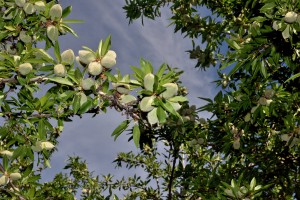
Observers are reporting rapid growth rates within the region’s orchards as the warm temperatures push nut development ahead aggressively. Nuts have moved through the initial differentiation stage wherein smaller nuts that were not fertilized drop from the trees and are entering the second phase of shedding wherein nuts that the trees are unable to support to harvest are being shed. As is normally the case, varieties shed to different degrees, with Nonpareil typically retaining a greater percentage of its nuts while several California type varieties along with the Butte and Padre shed more aggressively. Growers and observers alike are reporting generally good crop sets, with the greatest variability observed within the Nonpareil, Winters and Aldrich varieties. While all growers in the region would rather have received a good amount of rain since the completion of the bloom, the overwhelmingly dry conditions have resulted in very low disease pressure, with morning dew providing the only form of moisture on the foliage. As a result, orchards throughout the region are virtually free of fungal diseases and in generally good condition.
Rising temperatures have inspired growers to begin the irrigation season, drawing water from their wells and from early releases from local districts. Growers who normally receive water from the federal Central Valley Project already know that they will not receive any water this year, while those drawing water from the State Water Project are expecting 25% of their contracted allocation. Observers have reported that final allocations have not yet been announced by local districts, and growers in those areas are expecting word within the next few weeks. In any event, the dry winter will force growers to rely heavily on their own resources to provide the water needed to support their crops.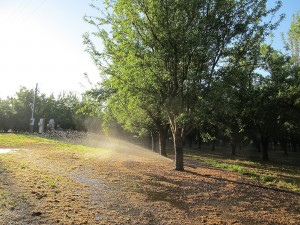
In addition to irrigating, growers throughout the region have been working to complete the wide range of tasks required to support the developing crop. Fertilizers are being applied, both in dry and liquid forms and growers have been sending tractor drawn flail mowers into the orchards to control vegetation in an effort to reduce water consumption. Native plants growing within the orchards aid water penetration and act as a nursery sight for beneficial insects. However, plant growth also consumes precious water, forcing growers to make difficult decisions on how to manage their orchard floors. Some will simply mow the growth to reduce the amount of foliage while others may opt to eliminate it entirely.
Growers are also monitoring insect populations within their orchards. Observers have noted Navel Orange Worm, NOW, larvae found within mummy nuts remaining in the trees and Pest Control Advisors have set out pheromone traps designed to attract male NOW moths and egg traps to monitor egg laying by females. Growers are also watching for signs of Leaf-Footed Plant Bugs moving in from grassland areas as they dry out and for indications of web-spinning spider mites. With all that in mind, concerns of water will dominate grower decisions during the current growing season.
Central Region
Warm conditions reigned over the central region during the latter half of March, setting a few records and generally providing excellent conditions for the developing crop. Daily maximum readings were reported predominately in the lower 70’s to upper 80’s during the period, with readings dipping briefly into the upper 60’s on the 23rd and 24th of the month, when a very weak system dropped trace amounts of rain in northern areas of the region during the overnight hours. Morning minimum readings exhibited a bit more stability, ranging from the lower 40’s to lower 50’s each day.
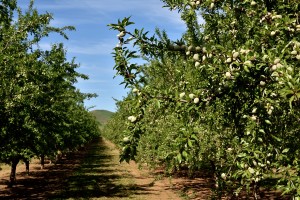 Crop development continues at a brisk pace in the northern San Joaquin Valley, under the influence of the warm conditions. Throughout the region, the differentiation process has been completed in all varieties and the smallest of the nuts have been shed from the trees. The warm temperatures have aided this process, by allowing a greater proportion of the smaller sized nuts to be retained. Advanced orchards around the region are now entering the second phase of shedding, a process that normally occurs during mid-April, thus signaling the advance nature of the crop.
Crop development continues at a brisk pace in the northern San Joaquin Valley, under the influence of the warm conditions. Throughout the region, the differentiation process has been completed in all varieties and the smallest of the nuts have been shed from the trees. The warm temperatures have aided this process, by allowing a greater proportion of the smaller sized nuts to be retained. Advanced orchards around the region are now entering the second phase of shedding, a process that normally occurs during mid-April, thus signaling the advance nature of the crop.
While the South San Joaquin and Oakdale Irrigation Districts have begun their delivery season, allowing growers there to begin irrigating, growers in the Turlock and Modesto Irrigation District are still waiting for their canals to be filled. Growers in the Turlock and Modesto Districts are anticipating receiving approximately 16 inches of water this year, with deliveries beginning within the next two weeks. Some growers who have no water of their own available have opted to purchase water drawn from district-owned deep wells in order to meet their orchard’s early season needs. While the elevated temperatures have provided strong support for the developing crop, they have also increased water consumption, increasing stresses in orchards that have not yet been irrigated. Breezy conditions on several days during the period exacerbated the situation, as wind speeds in the teens increased water movement through the trees. Growers in the Merced Irrigation District face particularly grim prospects this year, with no deliveries of surface water available. Growers there are relying solely on deep wells this year, with growers who have no wells of their own forced to purchase water from wells owned by the District or their neighbors. Growers within the boundaries of the federal Central Valley Project will also receive no surface water this year and face a similar fate.
A wide range of variation in orchard health can be easily seen within the region’s plantings. Orchards irrigated with high pH water from deep wells have begun taking on a noticeably yellow hue. This is most easily observed along the west side of the valley. However, the symptoms can be highly localized with adjacent orchards receiving water from different wells showing no sign of problems.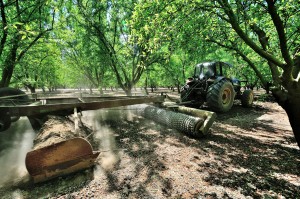
To provide support for the crop, growers have been fertilizing their orchards, mowing weed growth and controlling gophers within the orchards. Traps to monitor populations of Peach Twig Borer and Navel Orange Worm have also been set in the orchards, which will help to properly time treatments that may be required later in the season. Growers are also on high alert for signs of Leaf-Footed Plant Bugs. University of California Farm Advisors have sounded the alarm for this serious pest, noting that the insect tends to move from grassland areas as they dry. Growers will focus their attention on the Sonora, Aldrich, Price and Fritz varieties, which this insect prefers.
While the risk of frost has not completely vanished, the elevated daytime temperatures eliminated the risk of damage during the month and growers are hopeful that morning temperatures will remain at comfortable levels in the next few weeks. Over the next month, irrigation will be the prime activity as growers balance limited supplies of water against the increasing moisture needs of their orchards.
Southern Region
Warm, dry conditions dominated the weather in the southern San Joaquin during the second half of March, setting a few new high temperature records in the period’s final week. Comfortable temperatures dominated early in the period, with daily maximum readings reported between the upper 60’s to upper 70’s . However, temperatures turned decidedly warmer in the period’s closing days, with readings rising into the upper 80’s and lower 90’s in several locations. Morning low readings were much more stable, ranging predominately between the mid 40’s and lower 50’s throughout the period.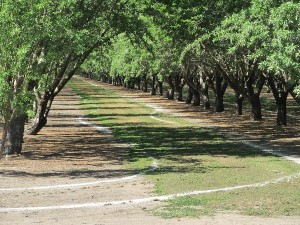
While the weather has provided excellent conditions for the developing crop, pushing growth rates aggressively, the unseasonably warm temperatures have exacerbated grower’s concerns about water. Surface water from local irrigation districts is largely unavailable this year, compelling growers in the southern San Joaquin to rely on wells. However, growers are already encountering problems with their wells that were not noted until mid to late summer last year. Flow rates coming from wells have declined and growers have reported that several wells have collapsed. At this point, the crop is developing rapidly and is in generally good condition. However, adverse impacts from moisture stress will become more dominant in the coming weeks if growers are not able to meet the trees moisture requirements. While the water required to grow almonds has received quite a bit of coverage in the popular media over the past year, it must be noted that nearly all crops grown in the Central Valley require the same quantity of water, 3 to 4 acre/feet per acre. In fact, the wide-spread adoption of low-volume drip and micro-sprinkler irrigation practices, which were pioneered by almond growers has increased yields by optimally providing water to the trees while minimizing losses.
Observers have reported that the signs of water issues, both quantity and quality can be easily seen within the region’s orchards. There is quite a bit of variability in crop loads visible within the region’s orchards, with plantings that experienced the greatest degree of stress last year exhibiting correspondingly weaker crop loads this year. Orchards displaying a decidedly yellow cast can also be easily spotted in the southern San Joaquin; the result of groundwater with too high a pH value.